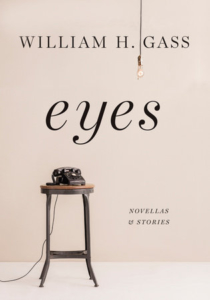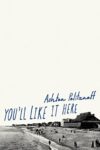I do not pretend to be in the possession of any secrets; I have no cause I espouse; I do not presume to reform my readers, or attempt to flatter their egos either. My loyalty is to my text, for that is what I am composing, and if I change the world, it will be because I’ve added this or that little reality to it; and if I alter any reader’s consciousness, it will be because I have constructed a consciousness of which others may wish to become aware, or even, for a short time, share. The reader’s freedom is a holy thing.
—William H. Gass, Finding a Form
It has been fifty years since William H. Gass published Omensetter’s Luck, which established him as a major new voice in American literature at the late age of 42. He has since produced a body of work rivaled by few other authors, yet he has earned the dubious distinction of being admired more widely as a writer of nonfiction. I suspect it has something to do with the final sentence in the above quotation, and whether the reader can reconcile that sentiment with the style they find within Gass’s fiction.
One of the pleasures and perils of Gass’s stories and essays is his style, which can perhaps best be described as always on; his loyalty to his text is always paramount, and can, at times, alienate readers. Just as it is edifying and inspiring to share his appreciative eye as he walks you through Italo Calvino’s Invisible Cities, it can be terrifying to share the misanthropic mind of the narrator of The Tunnel, whose hatred for mankind leads him to sympathize with Nazis. The reader’s freedom only applies until the cover of a book opens; after that, the reader is in the mind Gass has constructed and bound within its pages. This can lead some readers to make terrible errors, such as those reviewers of The Tunnel who attributed to Gass the narrator’s anti-Semitic sympathies.
The publication of Gass’s latest collection, Eyes: Novellas and Stories, provides an opportunity for a correction. Taken together, these stories offer a sample of the methodologies and preoccupations that have defined Gass’s fiction, and the book could serve as a primer on the virtuosity of his language, his careful layering of image, idea and action, his poignant portraits of minds suffering through miseries of their own making, and the wholesale devotion of his artistry to even the worst characters and the worst points of view. They present evidence for the case Gass has made throughout his career, in both his fiction and nonfiction, that a narrative composed in a high style largely consisting of meticulously crafted imagery and language can paint a picture that is every bit as convincing, as ‘real,’ as any conventionally written story.
Eyes begins with an epigraph from the poet Jan DeBlieu, and her definition of an eye points the thematic way for the six stories contained within this collection:
The point where an underground spring suddenly bursts to the surface is known as an eye. It is a place of mystery, where dry ground becomes soaked with life-giving water, and nature gives us a glimpse of all that happens out of the realm of human vision.
These novellas and stories, these eyes, in this sense, are not the organs that look around, taking in whatever images blunder into them, but windows with a view into hidden worlds, forgotten corners and neglected places. Gass has written that “there is scarcely a significant character in my work who is not a failure in the practice of ordinary existence, who does not lead a deflected life,” and readers will find in Eyes a cast of characters that bear out this description. “In Camera” and “Charity” feature characters in retreat from the world that is the arena of their failures. The unnamed narrator of “The Toy Chest” showcases a mind that is irretrievably broken trying unsuccessfully to piece its miserable memories together. Professor Arthur Devise, in “The Man Who Spoke With His Hands (An Exercise),” is on the run, as jumpy as the hands he speaks through, because his daughter is intent on embarrassing him with her nymphomania. The narrators of “Don’t Even Try, Sam” and “A Soliloquy for an Empty Chair” are failures at existence in the sense that their existence is impossible; the first is the piano that stars in Casablanca and the second is a metal folding chair. Through them all, Gass not only focuses on feelings repressed, desires obscured, and the many unexamined errors that make up any life, but also puns on that organizing image of the eye and creates the consciousness that is each story’s perceiving “I.”
Most of these stories suffer in comparison to previous, better works; unsurprising, given that much of Gass’s fiction attains a level of excellence few authors have ever achieved. The Tunnel, as previously mentioned, is a masterpiece. But these stories’ adherence to the organizing idea of the eye offers the reader unfamiliar with Gass’s proclivities an easy entry, and provides an anchoring assurance that there is purpose to these stories, that the consciousness contained in each one exists for a reason aside from merely asserting the small miracle of their existence. But of all the stories contained within this collection, only “In Camera” deserves a place alongside Gass’s best, and in one way it even surpasses all its predecessors.
It begins with a description of a photographic print dealer named Mr. Gab, his stupid assistant, and his shop. The immediate focus is the shop’s shutters and the dreariness of the street outside, which sets the stage for this passage to open up a window into the degree of Gab’s obsession with his prints:
He needed only the least light to see them down to their last shades of gray: an Atget was frequently imagined to be the state of his street outside — Atget, the documentarian. Perhaps he’d decide on the Atget of an intersection, of Angle de la rue L’homond et de la rue Rataud, its cobbles moist, in late light, sky like sour milk, taken in the quartier du Val-de-Grace, where on one wall a poster was papered to say un million, un million, a dozen times in a voice not ever husky. “Forever,” Mr. Gab would allow himself sometimes to murmur: cours de danse givre . . . forever . . . though the “cours” is gone, “danse” is gone, even before the War arrived in a taxi, they were gone, gone, cobbles gone too, now, probably, building likely, gone, the lamp most certainly, gone, and the teeth of steel, like those of a large rake, that crossed the rue high above every head — sure, sure — that crossed the top of the image straight through the sour-milk sky and over the tree at rue’s end — oh, yes — gone, quite gone, even the tree whose feet were hid behind a low wall, deep in the shot where the road disappeared into a vee as though down a drain — ah well — but by now, blown over, hauled off, firewooded, gone.
Gass immediately establishes the importance of photography both to the form the story will take and for its characters. In the place of his disheveled street, Gab imagines an image plucked from an Atget print. It is not the street itself that is transplanted there, for the street only now exists in the Atget image: a point punctuated by the use of “gone” like some funereal bell. The value of the print for Gab, specifically, is that it is his. “Right outside there, beyond that barred door, beyond the shuttered window, lay Atget’s modest little street still. Still . . . made of wavering lines of glis and shales of shine . . . Mr. Gab did not dare say aloud what he succinctly thought, as he looked out through his engraved eyes: I am Atget — the world is mine.”
Just like the other characters in the collection, Gab has fled from the world. He has not only fled into his shop, he has fled into photographs. “In Camera” at first seems an ode to a specific style of photography, and Gass invests a lot of narrative time and energy to lavish praise on specific photographs, which offers pleasures similar to his literary criticism. The reader can share his appreciative eye as he describes the works of artists — Josef Koudelka, Enzo Sellerio, Josef Sudek and Alvin Langdon Coburn, to name but a few — works he describes so well the reader may scuttle to a search engine to find not only the wondrous works themselves but the aptness of Gass’s description, like those wavering lines of glis and shales of shine. Yet there is a narrative purpose to Gass’s loving looks: Gab offers his appreciation of his favored photos to his stupid assistant, and he takes it upon himself to imbue in the young man his proscriptive view, that “Realism — truth — was the exclusive property of the photograph,” specifically, the black-and-white photograph, in all its gray glories.
[B]eneath the colored world . . . lie all the grays, the grays that go from the pale gray of bleached linen through all the shades of darkening, deepening graying grays that lie between, to the grays that are nearly soot black, without light: the gray beneath blue, the gray beneath green, yes, I should also say the gray beneath gray; and these grays are held in that gray continuum between gray extremes like books between bookends. U-Stu, pay attention, this is the real world, the gray gradation world, and the camera, the way an X-ray works, reveals it to our eyes, for otherwise we’ve have never seen it; we’d have never known it was there, under everything, beauty’s real face beneath the powders and the rouges and the crèmes.
Through his education, the reader comes to realize Gab’s stupid assistant is the main character of this story. The stupid assistant is an orphan taken in by Gab, and he calls the boy U-Stu, or, simply, Stu, both short for “You stupid kid.” Gab treats Stu at times with warmth, at others with hostility, which creates an odd tension between the two, because as Stu’s education progresses and his mind blooms, he nurtures a suspicion that Gab’s photos are all contraband, a tension that ultimately leads to the story’s climax and resolution.
But there is another conflict that exists between them, as Stu adopts his master’s crabbed view of art and truth and finds it wanting. Gab thinks that in Stu he has found a sympathetic listener; one who, condemned to pariah status by the circumstances of his birth, is similarly invested in finding in art what the world has withheld. “I want the world in — you see — in — the photo. What a world it is after all! Am I a fool? Not to know what the world is; what it comes to?” Gab appeals to Stu. “It is misery begetting misery, you bet; it’s meanness making meanness, sure; it’s calamity; it’s cruelty and greed and indifference; I know what it is, you know what it is, we know how it is, if not why — yet I want the world as it is rescued by the camera and redeemed.” Stu struggles to define his objections, constructing imaginary arguments with Gab in his mind; Stu finds, in some photos, a message, a no-no in Gab’s view of photography. Stu even takes his heresy so far as to find pleasure in painting, in color photographs, even, worse still, in the little slice of life he has been afforded as Gab’s ward.
These tensions are resolved in a set-piece so exhilaratingly beautiful that it would be a crime to reveal it in detail; it is enough to note it becomes clear that just as Gab has failed to indoctrinate Stu completely, Gab fails in imparting his selfish bitterness to Stu. The effect the ending achieves is similar to the one Gab experiences when looking at a Sudek print, when “Mr. Gab would inhale very audibly, as if a sigh had been sent him from somewhere else, because only once had the world realized these relations; they would never exist again.” Every element of the story up until its conclusion is used to achieve that effect; all are woven together to inspire in the reader a moment of recognition. Only through great fiction can this kind of moment be felt: the realization of disparate relations that produces indelible moments, ones that are engraved upon the mind in the same way a perfect print can etch an image on a viewer’s eye.
What sets this novella apart from Gass’s other works is the relationship between the two characters, as well as Stu’s sweetness, for he has written no other work that is so ultimately uplifting. In this way it is a fitting coda for his life’s work, as it answers the complaint that his stories and characters offer an unremittingly bleak view of the world. The strength of the stories in this collection, which may well be his last book of fiction, also may dispel some of the myths surrounding Gass — that he is a writer only other writers will appreciate, that what he has called his “rude mouth music” is merely masturbatory, that he is more concerned with image than emotion — and presents the possibility, even in his old age, that he may yet have more fiction to offer readers. A happy thought, even if wildly irrelevant: Gass has already done enough difficult work for a lifetime to secure his place in the pantheon of American fiction. It remains for the readers with attentive ears and appreciative casts of mind to surrender their freedom, if only for a short time, to discover how he has earned his place there.
Sho Spaeth lives in New York.
This post may contain affiliate links.








